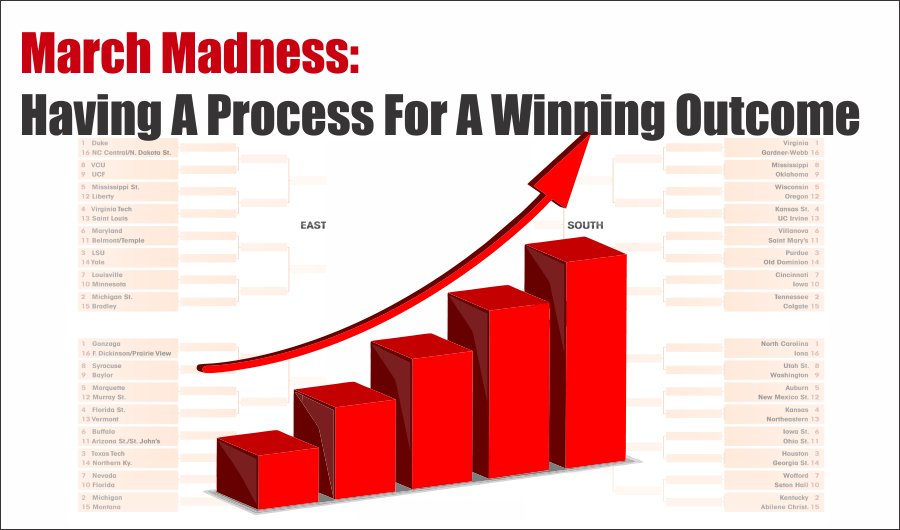We are coming upon that time of year when the markets play second fiddle to debates about which twelve seed could be this year’s Cinderella in the NCAA basketball tournament. For college basketball fans, this particular time of year is dubbed March Madness. The widespread popularity of the NCAA tournament is not just about the games, the schools, and the players, but just as importantly, it is about the brackets. Brackets refer to the office pools based upon correctly predicting the 67 tournament games. Having the most points in a pool garners bragging rights and, in many cases, your colleague’s cash.
Interestingly the art, science, and guessing involved in filling out a tournament bracket provides insight into how investors select assets, structure portfolios, and react during volatile market periods. Before we explain answer the following question:
When filling out a tournament bracket, do you:
A) Start by picking the expected national champion and then go backwards and fill out the individual games and rounds to meet that expectation?
B) Analyze each opening round matchup, picking winners, and then repeat the process with your second round matchups until you make your best guess at who the champion will be?

If you chose answer A, you fill out your pool based on a fixed notion for which team is the best in the country. In doing so, you disregard the potential path, no matter how hard, that team must take to become champions.
If you went with the second answer, B, you compare each potential matchup, analyze each team’s respective records, strengths of schedule, demonstrated strengths and weaknesses, record against common opponents and even how travel and geography might affect performance. While we may have exaggerated the amount of research you conduct, such a methodical game by game evaluation is repeated over and over again until a conclusion is reached about which team can win six consecutive games and become the national champion.
Outcome-Based Strategies
Outcome-based investment strategies start with an expected result, typically based on recent trends or historical averages. Investors following this strategy presume that such trends or averages, be they economic, earnings, prices, or a host of other factors, will continue to occur as they have in the past. How many times have you heard Wall Street “gurus” preach that stocks historically return 7%, and therefore a well-diversified portfolio should expect the same return this year? Rarely do they mention corporate and economic fundamentals or valuations. Many investors blindly take the bait and fail to question the assumptions that drive the investment selection process.
Buy and hold and constant dollar cost averaging along with a host of passive strategies, all of which are largely agnostic to valuation, are outcome based strategies. These strategies can appear full proof for years on end as we have been witnessing. However, as seen twice in the last 20 years, when these strategies are followed blindly without appreciating a portfolio’s risk/return profile, dramatic losses will eventually occur. Outcome-based strategies break a cardinal rule of building wealth; avoid as much of the downside as possible in bear markets.
“The past is no guarantee of future results” is a typical investment disclaimer. However, it is this same outcome-based methodology and logic that many investors rely upon to allocate their assets.
Process-Based Strategies
Process-based investment strategies, on the other hand, have methods that establish expectations for the factors that drive asset prices in the future. Such analysis normally includes economic forecasts, technical analysis, and a bottom-up assessment of an asset’s ability to generate cash flow. Process-based investors do not just assume that yesterday’s winners will be tomorrow’s winners, nor do they diversify just for the sake of diversification. These investors have a method that helps them forecast the assets that are likely to provide the best risk/reward prospects and they deploy capital opportunistically.
Well managed process-based strategies, at times, hold significant amounts of cash. To wit, Warren Buffett is currently sitting on $128 billion in cash. This may have cost him over the last few years, but he has a reason for being so risk averse and is sticking to his process.
Buffett and others are certainly not enamored with historically low cash yields on their cash per se, but they have done significant research and cannot find enough assets offering a suitable value/risk proposition in their opinion. These managers are not compelled to buy an asset because it “promises” a historical return.
What Are We?
At RIA Advisors, we follow a process. We use a combination of technical and fundamental analysis, along with a strong assessment of macroeconomic factors to develop an investing framework and investment guidelines. This process allows us to:
- Properly choose assets for the short term as well as the longer term (trading vs. investing).
- Determine the proper allocations to various asset classes and sub-asset classes.
- Measure and monitor risk which helps limit downside by forcing us to exit positions when we are wrong, and take profits to rebalance asset weightings when we are right.
Investing can be easy at times as it was for most of 2019. It can also be very difficult as we are currently witnessing. Having a process and adhering to it does not eliminate risk, but it helps manage risks and limit mistakes. It also helps us sleep at night and avoids letting our emotions dictate our trading activity.
A or B?
Most NCAA basketball pool participants fill out tournament brackets, starting with the opening round games and progress towards the championship match. Sure, they have biases and opinions that favor teams throughout the bracket, but at the end of the day, they have done some analysis to consider each potential matchup. So, why do many investors use a less rigorous process in investing than they do in filling out their NCAA tournament brackets?
Starting at the final game and selecting a national champion is similar to identifying a return goal of 10%, for example, and buying assets that are forecast to achieve that return. How that goal is achieved is subordinated to the pleasant but speculative idea that one will achieve it. In such an outcome-based approach, decision-making is predicated on an expected result.
Considering each matchup in the NCAA tournament to ultimately determine the winner applies a process-oriented approach. Each of the 67 selections is based on the evaluation of the comparative strengths and weaknesses of teams. The expected outcome is a result of the analysis of the many factors required to achieve the outcome.
Summary
Winning a bracket has its benefits, while the costs are minimal. Managing wealth, however, can provide great rewards but is fraught with severe risks at times. Accordingly, wealth management deserves considerably more thoughtfulness than filling out a bracket.
Over the long run, those that follow a well-thought out, time-tested, process-oriented approach will raise the odds of success in compounding wealth by limiting damaging losses during major market setbacks and by being afforded generational opportunities when others are fearfully selling.






